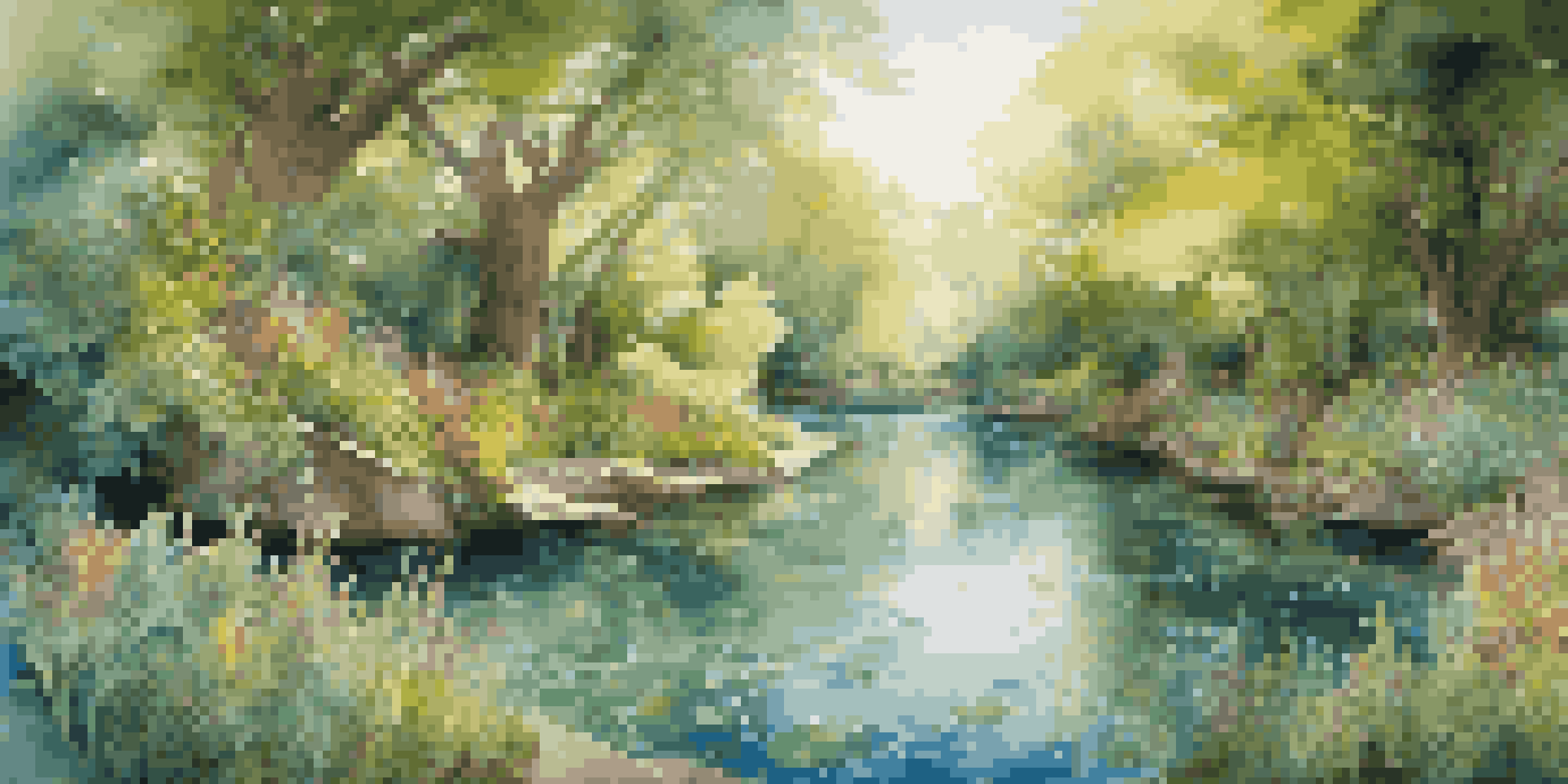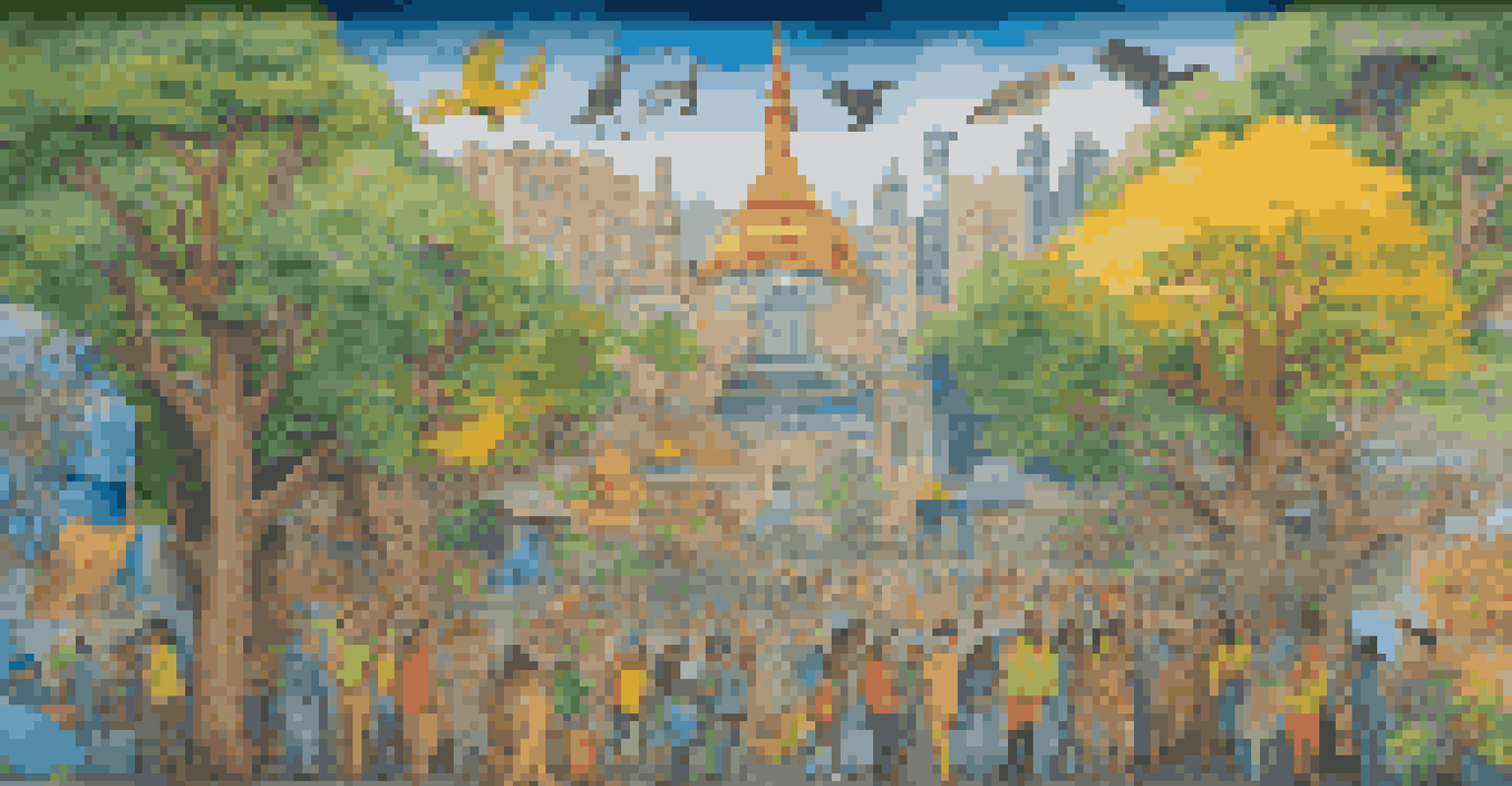Cultural Narratives in Environmental Art: A Storytelling Approach

Understanding Cultural Narratives and Their Importance
Cultural narratives are the stories that shape our identity and influence our perceptions. They are woven into the fabric of society, guiding how we interact with one another and the world around us. By understanding these narratives, we can see how they inform our values, beliefs, and actions, especially regarding environmental issues.
Art is the most beautiful of all lies; it is a powerful tool that can challenge our perceptions and inspire change.
In the realm of environmental art, cultural narratives play a pivotal role in conveying messages about nature and sustainability. Artists often draw on these narratives to evoke emotions and provoke thought, making complex environmental issues more relatable. By tapping into shared stories, they create a connection that resonates with the audience, fostering a deeper understanding of the environmental challenges we face.
For example, an artist might explore indigenous stories that highlight a community's relationship with the land, showcasing the wisdom gained over generations. This approach not only honors those narratives but also invites viewers to reflect on their own connections to nature. Ultimately, understanding cultural narratives enriches our appreciation of environmental art and its power to inspire change.
The Role of Storytelling in Environmental Art
Storytelling is a timeless method of communication that transcends cultures and generations. In environmental art, storytelling helps to convey complex ideas in a more digestible format, allowing audiences to engage with the subject matter on a personal level. Through visual narratives, artists can illustrate the impact of climate change or habitat destruction in a way that statistics alone cannot.

Consider a sculpture that tells the story of a river's journey, illustrating its beauty and the obstacles it faces. This narrative not only captivates the audience but also emphasizes the urgency of protecting such vital ecosystems. By weaving stories into their work, artists transform abstract environmental concepts into tangible experiences that resonate with viewers.
Cultural Narratives Shape Identity
Cultural narratives influence our values, beliefs, and actions, particularly in relation to environmental issues.
Moreover, storytelling in environmental art can foster a sense of community and shared responsibility. When people see themselves in these narratives, they are more likely to feel motivated to take action, whether it's through advocacy, conservation, or simply changing their habits. In this way, storytelling becomes a catalyst for environmental awareness and activism.
Examples of Environmental Art as Cultural Narratives
Various artists worldwide have successfully used cultural narratives in their environmental art to raise awareness and provoke thought. For instance, the work of Olafur Eliasson often explores the relationship between nature and human perception. His installations not only provide visual spectacle but also invite viewers to reflect on their impact on the environment.
We won't have a society if we destroy the environment.
Another example is the work of Maya Lin, who gained fame for her Vietnam Veterans Memorial but has also created significant environmental installations. Her project 'What Is Missing?' aims to highlight the disappearance of ecosystems and species, employing storytelling techniques to emotionally engage audiences. Through these narratives, Lin connects personal loss with broader environmental issues, making her message even more poignant.
These examples illustrate how environmental art can serve as a powerful medium for cultural storytelling. By drawing on personal and collective narratives, artists can engage viewers in meaningful conversations about our relationship with the planet, encouraging them to reflect on their role in environmental stewardship.
The Impact of Cultural Narratives on Environmental Awareness
Cultural narratives have a profound impact on how we perceive and address environmental issues. They shape our understanding of nature, influence our behaviors, and guide policy decisions. When artists incorporate these narratives into their work, they can challenge prevailing attitudes and inspire new ways of thinking about our environment.
For example, an artwork that reflects the struggles of marginalized communities affected by environmental degradation can highlight injustices often overlooked in mainstream discourse. By centering these narratives, artists not only raise awareness but also amplify the voices of those most affected by environmental change. This approach fosters empathy and encourages viewers to reconsider their perspectives.
Storytelling Engages Audiences
Through storytelling, environmental art makes complex ideas more relatable and fosters a sense of community and responsibility.
As more individuals engage with these narratives through art, they become motivated to advocate for change. The emotional resonance of storytelling can push people to act, whether through community initiatives or by supporting environmental policies. In this way, cultural narratives in environmental art play a crucial role in driving awareness and fostering a collective sense of responsibility.
Bridging Cultures Through Environmental Art
Environmental art can serve as a bridge between different cultures, highlighting shared values and concerns regarding nature. By showcasing diverse cultural narratives, artists can create a dialogue that transcends geographic and cultural boundaries. This connection fosters a sense of global community, emphasizing that environmental issues affect us all, regardless of where we come from.
For instance, collaborative art projects involving artists from different backgrounds can bring together various perspectives on environmental challenges. These collaborations often produce rich, multifaceted narratives that celebrate cultural diversity while addressing universal themes of sustainability and conservation. Such projects not only educate audiences but also inspire collective action.
Through this process, environmental art becomes a tool for unity in the face of pressing environmental crises. By sharing stories that resonate across cultures, we can foster a more inclusive approach to environmental advocacy, ultimately working together towards a sustainable future that respects all voices.
Challenges in Representing Cultural Narratives
While incorporating cultural narratives in environmental art can be powerful, it also presents certain challenges. One significant issue is the risk of cultural appropriation, where artists might unintentionally exploit cultural stories without proper understanding or respect. This can lead to misrepresentation and a disconnect between the narrative and the communities it represents.
To navigate this challenge, artists must engage with cultural narratives thoughtfully and ethically. Building relationships with communities and seeking their input can help ensure that the stories told are authentic and respectful. This collaborative approach not only enriches the artwork but also honors the cultural significance of the narratives being represented.
Collaborative Art Bridges Cultures
Environmental art can connect diverse cultures by highlighting shared values and inspiring collective action towards sustainability.
Additionally, the complexity of environmental issues can make it difficult to convey a singular narrative. Artists must balance the need for clear communication with the richness of diverse experiences. This requires careful consideration and a commitment to representing multiple perspectives, ultimately enhancing the depth and impact of their work.
The Future of Cultural Narratives in Environmental Art
As we move forward, the role of cultural narratives in environmental art will likely become even more significant. With the ongoing climate crisis, artists have a unique opportunity to use their platforms to advocate for change and inspire action. By continuing to draw on cultural narratives, they can engage audiences in meaningful conversations about the environment and our collective responsibility.
Digital technologies also open up new avenues for storytelling in environmental art. Virtual reality and interactive installations can immerse viewers in narratives, allowing them to experience the environment in ways that evoke empathy and understanding. These innovations can enhance the emotional connection between the audience and the artwork, making the messages even more impactful.

Ultimately, the future of cultural narratives in environmental art lies in collaboration and inclusivity. By embracing diverse voices and stories, artists can create powerful works that not only raise awareness but also foster a sense of shared responsibility for our planet. As we continue to navigate environmental challenges, storytelling will remain a vital tool for inspiring change and promoting understanding.